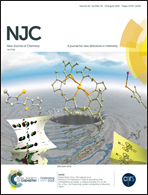Development of an electrochemical sensor based on a functionalized carbon black/tungsten carbide hybrid composite for the detection of furazolidone†
Abstract
In this study, the simple sonochemical synthesis of functionalized carbon black (f-CB) anchored with tungsten carbide (WC) is used to prepare a novel electrocatalyst for the electrochemical detection of furazolidone (FU) by modifying screen-printed carbon electrodes (SPCE). X-ray diffraction, scanning electron microscopy, transmission electron microscopy, and Raman spectroscopy were utilized to investigate the crystal structure, surface morphology and elemental composition of the hybrid composite. The results confirmed the successful formation of uniformly distributed flake-like WC on the surface of f-CB. Due to its peculiar and outstanding morphological structure, an f-CB/WC/SPCE electrode has an enriched electroactive surface area of 0.4105 cm2. The electrocatalytic efficiency of furazolidone was studied using cyclic voltammetry and amperometric techniques. The f-CB/WC composite displayed an outstanding synergic effect in detecting the ultra-level presence of FU, with a limit of detection of around 0.6 nM and an ultra-dynamic range of 0.001–1150 μM, which outshone other reported FU sensors. Therefore, it is evident that the preparation method can be successfully applied to bovine albumin serum and pharmaceutical tablets with acceptable recovery.



 Please wait while we load your content...
Please wait while we load your content...